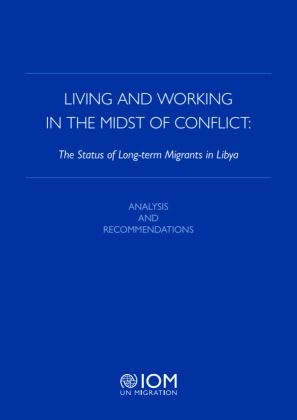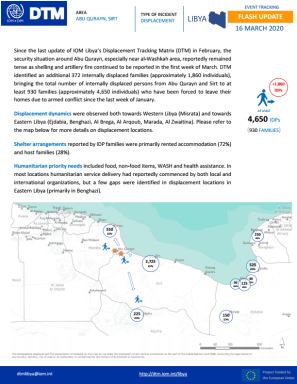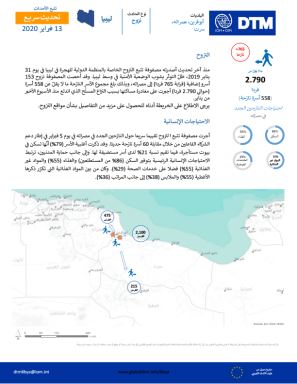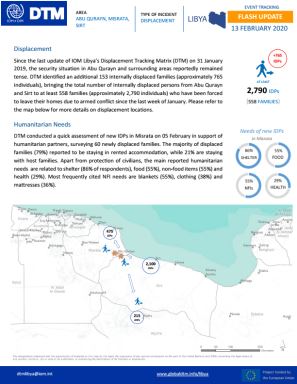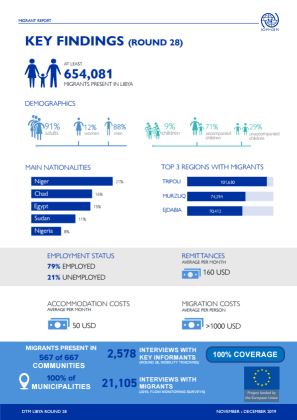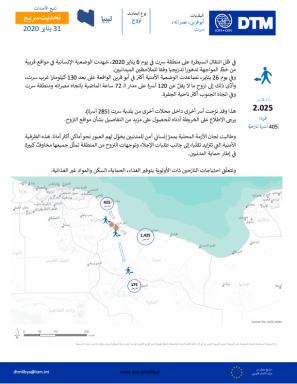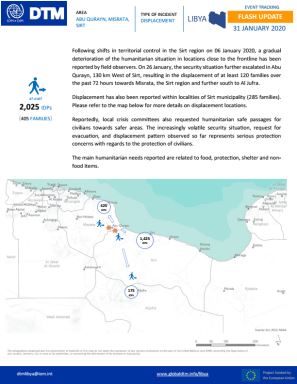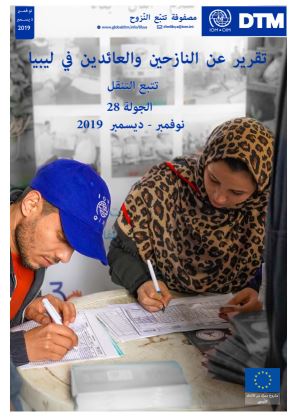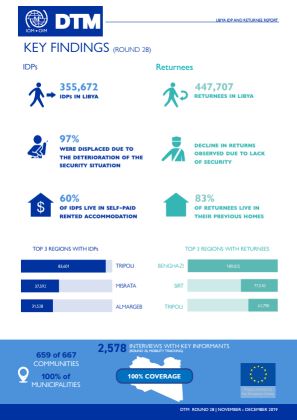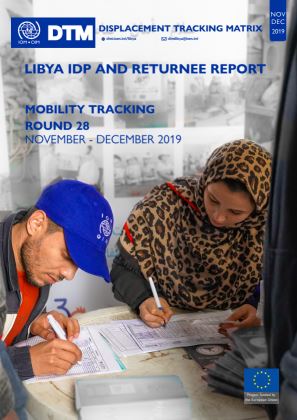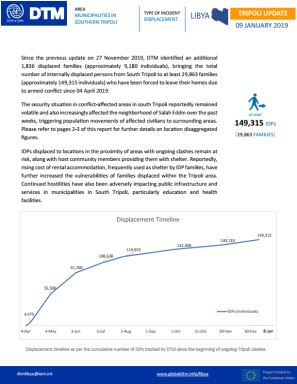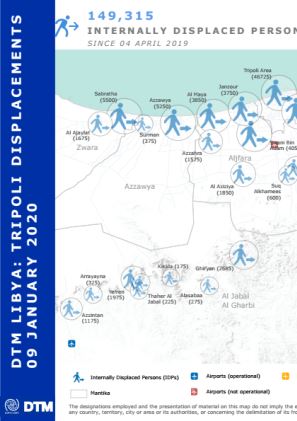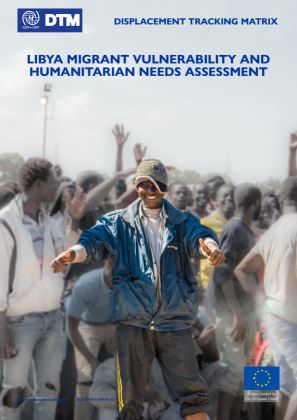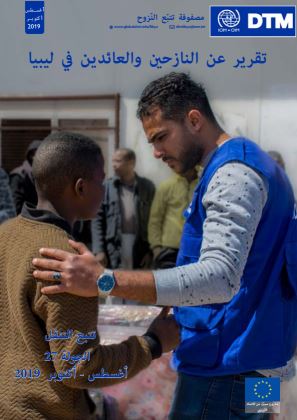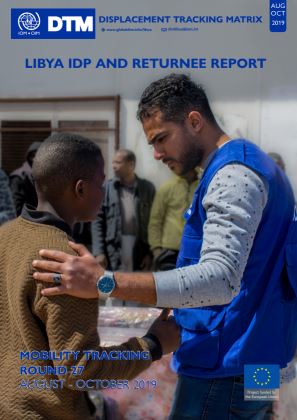-
Countries
-
Data and Analysis
-
Special Focus
-
Crisis Responses
Libya
About Libya
Libya is a geographically vast country with several regions that are difficult to access. In order to understand the full scope of humanitarian assistance that is needed throughout the country, IOM established the Displacement Tracking Matrix (DTM) programme in 2016 in order to provide a common operating picture concerning the movement of populations in Libya, allowing humanitarian actors to provide timely assistance to those in need. Following the escalation of conflict and insecurity in 2014, the security situation has remained volatile since with fluctuations in the intensity of localized clashes. Congruently, conflict has caused new displacements, often in areas ill-equipped to accommodate large population movements while also negatively impacting the large migrant population residing and transiting through Libya. More recently, the capital Tripoli was heavily affected by displacement waves in September 2018 and April 2019.
DTM’s mobility tracking and flow monitoring activities identified many migrants in-country to be in need of various forms of assistance. Libya’s geographic location, resources and work opportunities has made it both a country of destination and transit for migrants for many years. Despite the deterioration of the security situation since 2011 migrants continue coming to and transiting through Libya, the majority from Sub-Saharan and North African countries.
In this complex operating environment, DTM Libya has been providing a common operating picture concerning the movement of populations in Libya since 2016, allowing humanitarian actors to provide timely assistance to those in need. Through its mobility tracking, flow monitoring and needs assessment activities, DTM Libya has established itself as data hub for quantitative data on migratory flows to and within Libya, migrant presence in Libya disaggregated by nationality and area, as well as humanitarian needs of migrants, internally displaced population and returnees. All activities are implemented through periodical bi-monthly data collection cycles, allowing trend analysis over time to provide evidence-base for both policy-level discussions and to guide humanitarian action.
In order to facilitate humanitarian interventions, DTM works closely with IOM’s other programmes through referring identified populations in need of assistance at flow monitoring points to IOM’s Direct Assistance, Health, Voluntary Humanitarian Return (VHR), Protection and Migrant Rapid Response Mechanism (MRRM) programmes. Furthermore, DTM Libya supports other humanitarian partners through providing emergency tracking updates in case of sudden population movements as well as facilitating humanitarian assessments for the Rapid Response Mechanism (RRM) jointly implemented by IOM, UNICEF, WFP and UNFPA.
For more information on IOM's activities in Libya, please visit the IOM Libya country office website.
Contact
DTM Libya
DTMLibya@iom.int
Current Donors
- EUTF
Libya — Detention Centre Profile Generator (March 2020)
Detention Centre Profiling is a component of IOM Libya’s Displacement Matrix programme.
Libya — Living and Working in the Midst of Conflict: The Status of Long-term Migrants in Libya
To assess the circumstances of long-term migrants in conflict-affected Libya, IOM Libya’s Research Team, Displacement Tracking Matrix (DTM) programme and the Columbia University School of International and Public Affairs (SIPA) conducted this study in 2019 with
Libya — Abu Qurayn, Sirt, Misrata Flash update 3 (16 March 2020)
Since the last update of IOM Libya’s Displacement Tracking Matrix (DTM) in February, the security situation around Abu Qurayn, especially near al-Washkah area, reportedly remained tense as shelling and artillery fire continued to be reported in the first week of March.
Libya — Detention Centre Profile Generator (February 2020)
Detention Centre Profiling is a component of IOM Libya’s Displacement Matrix programme. It is a data oriented tool that routinely provides specific sex and age demographic data and key sectorial information on individuals held in Libya’s detention Centres on the date of assessment.
Libya — Abu Qurayn, Sirt, Misrata Flash Update 2 (13 Feb 2020) [Arabic]
منذ آخر تحديث أصدرته مصفوفة تتبع النزوح الخاصة بالمنظمة الدولية للهجرة في ليبيا في يوم 31 يناير 2019، ظلّ التوتّر يشوب الوضعية الأمنية في وسط ليبيا.
Libya — Abu Qurayn, Sirt, Misrata Flash update 2 (13 Feb 2020)
Since the last update of IOM Libya’s Displacement Tracking Matrix (DTM) on 31 January 2019, the security situation in Abu Qurayn and surrounding areas reportedly remained tense.
Migrant Report Key Findings Round 28 (Oct-Dec 2019)
This report presents the findings of DTM Round 28 (October - December 2019) data collection, in which at least 654,081 migrants from 40 countries of origin were identified in Libya.
Libya — Migrant Report 28 (Oct-Dec 2019)
This report presents the findings of DTM Round 28 (October - December 2019) data collection, in which at least 654,081 migrants from 40 countries of origin were identified in Libya.
Feb 12 2020
Libya — Migrant Report 28 (Oct-Dec 2019)
Libya — Detention Centre Profile Generator (January 2020)
Detention Centre Profiling is a component of IOM Libya’s Displacement Matrix programme. It is a data oriented tool that routinely provides specific sex and age demographic data and key sectorial information on individuals held in Libya’s detention Centres on the date of assessment.
Libya — Abu Qurayn, Sirt, Misrata Flash update (31 Jan 2020) [Arabic]
في ظل انتقال السيطرة على منطقة سرت في يوم 6 يناير 2020، شهدت الوضعية الإنسانية في مواقع قريبة من خطّ المواجهة تدهورا تدريجيا وفقا للملاحظين الميدانيين. وفي يوم 26 يناير، تصاعدت الوضعية الأمنية أكثر في أبو قرين الواقعة على بعد 130 كيلومترا غرب سرت، وأدّى ذلك إلى نزوح ما لا يقلّ عن 120 أسرة ع
Libya — Abu Qurayn, Sirt, Misrata Flash update (31 Jan 2020)
Following shifts in territorial control in the Sirt region on 06 January 2020, a gradual deterioration of the humanitarian situation in locations close to the frontline has been reported by field observers.
Libya — IDP & Returnee Report, Round 28 (Nov-Dec 2019) [Arabic]
يستعرض هذا التقرير نتائج الجولة الثامنة والعشرين المستخلصة من عمل وحدة تتبّع التنقل الخاصّة بمصفوفة تتبع النزوح في ليبيا والتي تغطّي الفترة . الممتدة بين شهرس نوفمبر وديسمبر من سنة 2019 وخلال الجولة 28 ، ارتفع عدد النازحين داخليا في ليبيا من 343,180 نازحا إلى 355,672 نازحا.
Jan 24 2020
Libya — IDP & Returnee Report, Round 28 (Nov-D…
Libya — IDP And Returnee Key Findings Report 28 (Nov-Dec 2019)
This report presents the Key findings of Round 28 of the mobility tracking component of the Displacement Tracking Matrix (DTM) programme in Libya.
Libya — IDP & Returnee Report, Round 28 (Nov-Dec 2019)
This report presents the findings of Round 28 of the mobility tracking component of the Displacement Tracking Matrix (DTM) programme in Libya, covering the reporting period from November to December 2019.
Jan 24 2020
Libya — IDP & Returnee Report, Round 28 (Nov-D…
Libya — Detention Centre Profile Generator (December 2019)
Detention Centre Profiling is a component of IOM Libya’s Displacement Matrix programme. It is a data oriented tool that routinely provides specific sex and age demographic data and key sectorial information on individuals held in Libya’s detention Centres on the date of assessment.
خريطة عدد 17 للنزوح من طرابلس 09 يناير 2020
منذ آخر تحديث أصدرته مصفوفة تتبع النزوح في يوم 27 نوفمبر 2019، أحصت المصفوفة نزوح 1.836 أسرة إضافية (حوالي 9.180 فردا) عن آخر أرقام مسجّلة للنازحين من جنوب طرابلس ، وبذلك بلغ مجموع الأسر النّازحة ما لا يقلّ عن 29.863 أسرة (أي حوالي 149.315 فردا) نزحت من مساكنها منذ ابتداء الاشتباكات المسلّحة يوم
Jan 09 2020
خريطة عدد 17 للنزوح من طرابلس 09 يناير 2020
تحديث سريع حول طرابلس -09 يناير 2020
منذ آخر تحديث أصدرته مصفوفة تتبع النزوح في يوم 27 نوفمبر 2019، أحصت المصفوفة نزوح 1.836 أسرة إضافية (حوالي 9.180 فردا) عن آخر أرقام مسجّلة للنازحين من جنوب طرابلس ، وبذلك بلغ مجموع الأسر النّازحة ما لا يقلّ عن 29.863 أسرة (أي حوالي 149.315 فردا) نزحت من مساكنها منذ ابتداء الاشتباكات المسلّحة يوم
Jan 09 2020
تحديث سريع حول طرابلس -09 يناير 2020
Tripoli Update (09 January 2020)
Since the previous update on 27 November 2019, DTM identified an additional 1,836 displaced families (approximately 9,180 individuals), bringing the total number of internally displaced persons from South Tripoli to at least 29,863 families (approximately 149,315 individuals) who have been
Jan 09 2020
Tripoli Update (09 January 2020)
Tripoli Displacement Map #17 (09 January 2020)
Since the previous update on 27 November 2019, DTM identified an additional 1,836 displaced families (approximately 9,180 individuals), bringing the total number of internally displaced persons from South Tripoli to at least 29,863 families (approximately 149,315 individuals) who have been forced
Jan 09 2020
Tripoli Displacement Map #17 (09 January 2020)
LIBYA - MIGRANT VULNERABILITY AND HUMANITARIAN NEEDS ASSESSMENT
This report presents the analysis and findings on the migrant vulnerability and humanitarian needs in Libya, via use of DTM Flow Monitoring Surveys (FMS) and Mobility Tracking Multisectoral Location Assessments (MSLA).
Libya — IDP & Returnee Report, Round 27 (Aug-Oct 2019) [Arabic]
يستعرض هذا التقرير نتائج الجولة السابعة والعشرين المستخلصة من عمل وحدة تتبّع التنقل الخاصّة بمصفوفة تتبع النزوح في ليبيا والتي تغطّي الفترة الممتدة من شهر أغسطس إلى شهر أكتوبر من ، سنة 2019 وخلال الجولة 27 ، ارتفع عدد النازحين داخليا في ليبيا من 301.407 إلى 343.180 نازحا.
Dec 15 2019
Libya — IDP & Returnee Report, Round 27 (Aug-O…
Libya — IDP and Returnee Key Findings Report 27 (Aug-Oct 2019)
This report presents the findings of Round 27 of the mobility tracking component of the Displacement Tracking Matrix (DTM) programme in Libya, covering the reporting period from August to October 2019.
Libya — IDP & Returnee Report, Round 27 (Aug-Oct 2019)
This report presents the findings of Round 27 of the mobility tracking component of the Displacement Tracking Matrix (DTM) programme in Libya, covering the reporting period from August to October 2019.
Dec 15 2019
Libya — IDP & Returnee Report, Round 27 (Aug-O…
Pagination
Pagination
- First page
- Previous page
- 1
- 2
- 3
- 4
- 5



